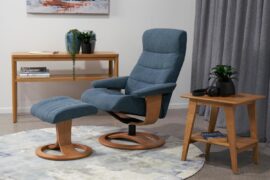From the industry-defining impact of the humble fabric swatch to the resonant statement on relevance and innovation at this year’s Salone del Mobile, Knoll’s material excellence continues to shape the world of design. Here, we explore this extraordinary legacy and look at how it informs the brand’s contemporary expression and the future of design.

May 20th, 2025
The modest fabric swatch is one of the most ubiquitous objects in the realm of design. A reliable guide, discreet point of reference and an unbound source of inspiration. Each humble fabric square – no matter how small – is an expansive sensory portal to the rich heritage of textiles, the incredible craftsmanship woven in and amongst the threads, the creative process it galvanises, and the future emotional response it hopes to elicit. In essence, the simple swatch encapsulates the transformative power of one of the most consequential forces in design: materials.
But the swatch is not just a quiet reminder of the potent role of materials – it’s also a compelling symbol of pioneering innovation Knoll brought to the world of materiality. After all, the fabric swatch was invented by Florence Knoll herself.

From small things, big things grow
What made Florence’s invention so distinct was the fact that, as a trained architect, she had a particularly profound appreciation of materials, their distinct qualities and their consequential relationships with their environments and their occupants. This intimate understanding led Knoll to become the first company to attach humble squares of fabric to identification cards, accompanied by all the relevant information an interior designer might need.
This seemingly trivial innovation not only enriched the dialogue between designers and materials – it also set the company on a dynamic evolution that transcended the world of textiles into the abundant realm of wood, marble and metal. Over the years, this enthusiastic material exploration has yielded some of the most iconic objects.

The creative freedom of crossing wires
Harry Bertoia’s wire chair collection – undoubtedly one of the most recognisable forms in the world of design – is a compelling example of this investigative, material-first attitude. The ingenious designer didn’t simply set out to understand metal as a material – Bertoia invented a whole new production process to bring his bold, rod-ridden vision to life. In collaboration with Richard Schultz and Don Petitt, he created the process of hand-bending and hand-weaving the rods into a frame, and then individually welding each one in place, creating a manufacturing technique still used to make this collection today.
This pioneering use of metal, which later formed a base for other iconic designs, like the Brno Chair, redefined the structural potential and the visual interpretation of metal. “Wire forms have a great range of expressions,” Bertoia once said. “Their constructions pertain to space rather than ground, and their configurations can be light, airy, almost floating.”
This consequential innovation set the design powerhouse on the trajectory of becoming a leader in innovative use of metal, reinforcing the fact that Knoll’s design collaborators leveraged the inherent properties of materials to make art, not just furniture.

The precise craftsmanship of natural stone
This artful experimentation with metal certainly didn’t mean that Knoll didn’t appreciate the more traditional materials – stunning pieces by Florence, Eero Saarinen and the iconic Grasshopper Tables by Piero Lissoni poignantly showcase Knoll’s exquisite proficiency in working with marble’s enduring beauty.
Using the most extraordinary, highest quality and sustainably sourced stones from the finest quarries in Italy and Slovenia, Knoll’s expert stone masters would first analyse the veining and patterns to determine the final cut to maximise the quality and natural beauty of the slabs. Then, skilled artisans would hand-finish the edges before applying the finish and integrating them into Knoll’s exquisite designs, invariably engineered to showcase marble’s timeless aesthetic above all else. This ability to recognise each material’s distinct properties and genuinely celebrate them still underpins Knoll’s ethos today.

“Each material has specific characteristics, which we must understand if we want to use it,” Ludwig Mies van der Rohe once said, and Knoll’s proficiency in working with marble certainly showcases their profound appreciation of marble and commitment to time-honoured techniques which have been in place since 1958.
For the love of wood
Wood stands out as another foundational material that has defined Knoll’s design vernacular over the years. Its unmatched fusion of organic, welcoming warmth, reassuring durability and clean, universal aesthetic has propelled some of Knoll’s most formative designs, including Jen Risom’s early Scandinavian collections or the industry-first, all-wood office system that reimagined the commercial workplace in the early 1970s.
Knoll’s relationship with timber has also exemplified the organisation’s broader sustainability ethos. Knoll started implementing clean technology initiatives in 1978, and today, it continues to foster design and manufacturing practices that help protect this precious resource.

With the increasing influence of biophilic design principles and urgent environmental action, sustainable timber is emerging as a foundational component of future-forward designs, and Knoll is leading the way in promoting its responsible sourcing through their collections. These efforts, highlighted by the ISO 14001 and Forest Stewardship Council® (FSC® C028824) certifications, demonstrate Knoll’s profound commitment to materiality that bridges meticulous craftsmanship, sustainable consciousness and future-forward leadership.
Salone del Mobile 2025: Contemporary expressions of a material legacy
Seamlessly embodying this holistic material legacy within a contemporary setting, this year’s Salone del Mobile showcase unfolded as a compelling chapter in the brand’s evolving narrative of design excellence. A multifaceted affirmation of Knoll’s material-first ethos, the exhibition signalled a clear trajectory for future endeavours firmly rooted in heritage and pioneering, sustainable innovation.
The Knoll pavilion itself, designed by Kersten Geers and David Van Severen of OFFICE for the third successive year, served as an immediate and unambiguous statement: the minimalist, see-through structure was built from repurposed, recycled and recyclable materials, thoughtfully reinterpreted each year to resonate with the exhibited objects. This inherent transparency in construction mirrored a profound transparency of intent – the pavilion’s clean environment underscored the cyclical nature of design and Knoll’s unwavering commitment to environmental responsibility, setting a layered stage for the pieces exhibited within.

Forward-thinking forms, enduring material principles
The unveiled collections engaged in a dynamic and insightful dialogue with Knoll’s established material language and enduring design principles.
The Bibioni Sofa, an inaugural creation born from the architectural sensibilities of Sharon Johnston and Mark Lee of Johnston Marklee in partnership with Knoll, articulates their understanding of shaping spatial volumes into an upholstered form that gently envelopes the human body. Its sculptural expression, achieved through a nuanced interplay of generous curves and soft fabric applied over a supportive internal structure, speaks to Knoll’s long-standing mastery of upholstery and form-making, while echoing the brand’s legacy of architectural collaborations that redefine comfort and presence within a space. The object emerging from this nuanced dialogue between thoughtful material application and considered shape fosters a profound emotional connection of a trusted companion that, Johnston explains, “wants to be a good friend.”
This sense of welcoming familiarity is also explored in Jonathan Muecke’s Wood Collection, the first range he’s created in collaboration with Knoll. Operating fluidly between the disciplines of architecture and sculpture, Muecke crafted dining furniture that is pleasantly ordinary in its function and delightfully radical in its expression. An inconspicuous reminiscence of Knoll’s early all-wood collections, this contemporary all-timber range emerges as a deliberate exploration of the material by drawing attention to its inherent beauty and structural honesty through the gentle novelty of form.

The multi-disciplinary designer exposes the wood’s end grain and constructs forms from a single, repeated profile, reintroducing furniture as material markers that define human scale and occupy relational space, rather than static objects. This view harkens back to Knoll’s historical appreciation for the interconnectedness between materials and the objects’ interactions with their environments and, critically, their users.
In juxtaposition to Muecke’s singular material proposition, the Perron Bun Lounge Chair and Ottoman by Willo Perron introduce a contemporary vision of comfort realised through a striking material contrast. With their visual expression defined by a generously soft, almost ethereal upholstered cushion resting upon a precise, angular and somewhat austere steel frame, this deliberate juxtaposition of plush textile and engineered metal speaks to the design’s outstanding ability to achieve compelling visual intrigue and an inviting physical experience by combining diverse materials. The design also emerges as a modern interpretation of the dynamic forms made possible through innovative material use, drawing a conceptual parallel to Harry Bertoia’s pioneering work with wire and demonstrating how deliberate material tension can create an inviting sense of lightness and visual delight.
Completing this multifaceted dialogue between contemporary design and historical resonance, the reintroduction of Joseph D’Urso’s Occasional Tables served as a poignant reminder of Knoll’s enduring loyalty to material honesty and functional clarity.

First introduced in 1980, these tables – defined by the solid geometry of their welded steel frames – embody D’Urso’s preference for objects that appear engineered rather than styled. Their return highlights Knoll’s commitment to its expansive archive and the continued relevance of designs where material properties and construction methods are openly celebrated – a principle perfectly encapsulated by Ludwig Mies van der Rohe’s statement that each material possesses specific characteristics essential to its successful application.
This profound understanding is evident not only in the refined simplicity of the D’Urso tables but also in the presentation of new finishes for the iconic Barcelona Collection, which allows this 1920s Mies van der Rohe masterpiece to gracefully evolve through updated material palettes and finishes, while respecting its enduring integrity.
Collectively, the Knoll’s Salone del Mobile exhibition emerges as a powerful statement on continuity, relevance and innovation. The diverse collections convincingly illustrate how the spirit of material exploration and meticulous craftsmanship – a legacy initiated by Florence Knoll and thoughtfully carried forward by generations of other pioneering designers – remains vibrantly at the heart of the brand, yielding visionary collaborations and contemporary forms anchored by Knoll’s commitment to sustainable practices. This unwavering desire translates into innovative forms that, rather than just furniture, emerge as enduring contributions to the global design landscape that continuously shift the goalpost for its evolving future.
Locate your nearest MillerKnoll dealer, Australia’s exclusive destination for Knoll’s designs, to elevate your next project with an iconic piece embodying exceptional material legacy, enduring craftsmanship and inherently relevant design.
INDESIGN is on instagram
Follow @indesignlive
A searchable and comprehensive guide for specifying leading products and their suppliers
Keep up to date with the latest and greatest from our industry BFF's!

Sydney’s newest design concept store, HOW WE LIVE, explores the overlap between home and workplace – with a Surry Hills pop-up from Friday 28th November.

For a closer look behind the creative process, watch this video interview with Sebastian Nash, where he explores the making of King Living’s textile range – from fibre choices to design intent.

For those who appreciate form as much as function, Gaggenau’s latest induction innovation delivers sculpted precision and effortless flexibility, disappearing seamlessly into the surface when not in use.

Merging two hotel identities in one landmark development, Hotel Indigo and Holiday Inn Little Collins capture the spirit of Melbourne through Buchan’s narrative-driven design – elevated by GROHE’s signature craftsmanship.

From radical material reuse to office-to-school transformations, these five projects show how circular thinking is reshaping architecture, interiors and community spaces.

Designed by Woods Bagot, the new fit-out of a major resources company transforms 40,000-square-metres across 19 levels into interconnected villages that celebrate Western Australia’s diverse terrain.

In an industry where design intent is often diluted by value management and procurement pressures, Klaro Industrial Design positions manufacturing as a creative ally – allowing commercial interior designers to deliver unique pieces aligned to the project’s original vision.
The internet never sleeps! Here's the stuff you might have missed

Your main seating can be a stylish centrepiece, not just a functional chair.

We caught up with Abramo Manfrotto, CEO of Venetian decorative lighting brand LEUCOS, during a visit to Australia with dedece.